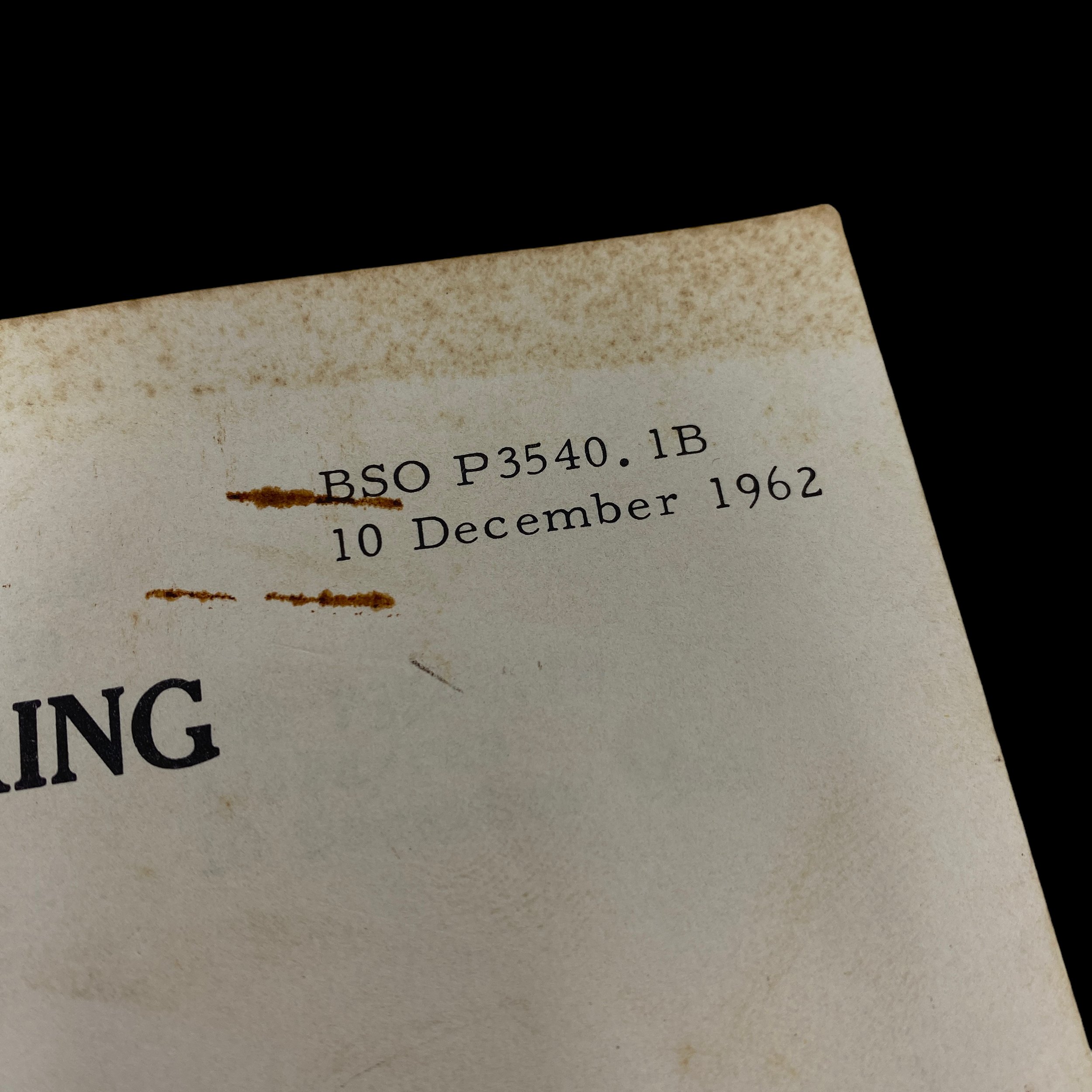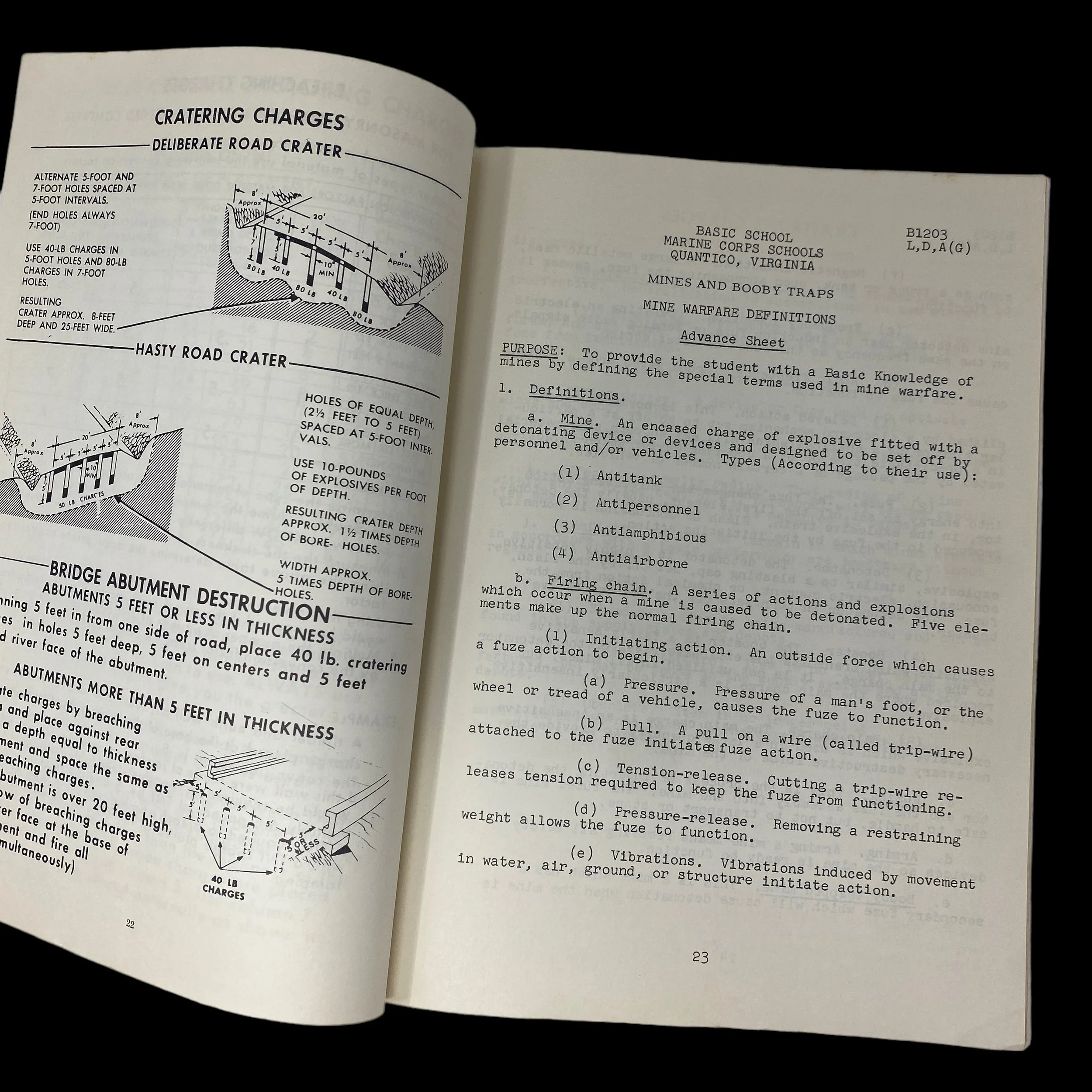RARE! 1962 Vietnam War “FIELD ENGINEERING” MARINE CORPS SCHOOL Quantico Virginia Training Manual (Booby Traps & Minefields)*


































RARE! 1962 Vietnam War “FIELD ENGINEERING” MARINE CORPS SCHOOL Quantico Virginia Training Manual (Booby Traps & Minefields)*
Comes with a hand-signed C.O.A.
This rare and museum-grade Vietnam War artifact was used at the infamous MARINE CORPS SCHOOL at Quantico, Virginia to train US Marines on “FIELD ENGINEERING”. Dated 1962 this extremely detailed Vietnam War manual was produced in very limited quantities and was used to teach about…the construction of emplacements and camouflage positions and equipment, demolitions, mines in booby traps, minefield laying, minefield, breaching and clearing, Soviet, mine warfare, and construction of wire obstacles. This is an extremely detailed document detailing some of the most confidential information for teaching US Marines about some of the most dangerous obstacles that they would encounter on the battlefield. This manual contains secret diagrams, pictures, maps, and data.
The Vietnam War, which lasted from 1955 to 1975, was a complex and protracted conflict that required innovative military strategies and tactics. Among the crucial elements of warfare during this period were the construction of emplacements and camouflage positions, the use of demolitions, mines, booby traps, minefield laying, breaching and clearing operations, and the implementation of wire obstacles. The Soviet influence on mine warfare also played a significant role in shaping the strategies used by both sides during the conflict.
Construction of Emplacements and Camouflage Positions
The construction of emplacements and camouflage positions was critical for both sides in the Vietnam War. Emplacements, such as bunkers and fortified positions, provided protection for troops from enemy fire and artillery. These structures were often constructed using locally available materials such as wood, sandbags, and earth, making them difficult to detect and target from the air.
Camouflage played an equally important role in concealing troop movements and positions. The dense jungle terrain of Vietnam provided ample natural cover, but soldiers on both sides became adept at crafting artificial camouflage using foliage and netting to hide their presence from enemy observation. This tactic not only made it harder for the enemy to locate troops but also allowed for surprise attacks.
Demolitions and Mines
Demolitions and mines were extensively used during the Vietnam War. Demolitions, in the form of explosives, were employed for various purposes, including destroying enemy infrastructure, such as bridges and roads, disrupting supply lines, and clearing landing zones for helicopters. Engineers on both sides became skilled in handling explosives to achieve their objectives.
Mines were a deadly tool in the Vietnam War, causing significant casualties to both military personnel and civilians. The Viet Cong and North Vietnamese Army (NVA) relied on mines as part of their guerrilla warfare tactics, using them to create booby traps and minefields. American forces, in response, developed specialized mine detection and clearing teams to counter this threat.
Booby Traps and Minefields
Booby traps and minefields were pervasive hazards in Vietnam. The Viet Cong were particularly adept at crafting ingenious booby traps, often using simple and readily available materials. These traps could be hidden in tunnels, along trails, or in abandoned buildings, posing a constant threat to American and South Vietnamese troops.
Minefields, on the other hand, were deliberately laid by both sides to disrupt enemy movement and channelize them into kill zones. The demarcation of minefields required precision and careful planning, often involving the use of maps and markers to ensure friendly forces did not inadvertently wander into these danger zones.
Breaching and Clearing Operations
Breaching and clearing operations were vital in dealing with enemy fortifications and obstacles. Engineers were tasked with developing tactics and equipment to breach enemy defenses. Bulldozers were used to clear vegetation and obstacles, while explosives were employed to create breaches in enemy positions.
Once a breach was established, infantry and combat engineers would work together to clear enemy positions, disarm booby traps, and neutralize mines. These operations were highly dangerous and required meticulous planning and coordination to minimize casualties.
Soviet Influence on Mine Warfare
The Soviet Union played a significant role in shaping mine warfare tactics during the Vietnam War. The Viet Cong and NVA received substantial support and training from the Soviets, who provided them with modern mines and expertise in their use. Soviet mines were often more sophisticated than their American counterparts, making them deadlier and harder to detect.
The Soviet influence extended beyond just equipment. Soviet advisors and military experts assisted the North Vietnamese in developing strategies for mine warfare, including the use of mines to disrupt American and South Vietnamese operations.
Construction of Wire Obstacles
Wire obstacles were a common feature of the Vietnam War, used to slow down and channelize enemy movements. Concertina wire, barbed wire, and bamboo stakes were often used to create these obstacles. They were employed to fortify defensive positions, protect bases, and impede enemy advances.
The construction of emplacements and camouflage positions, the use of demolitions, mines, booby traps, minefield laying, breaching and clearing operations, and the implementation of wire obstacles were all essential components of military engineering and tactics during the Vietnam War. Both sides in the conflict employed these techniques to gain a tactical advantage, resulting in a complex and challenging battlefield environment.
The Soviet influence on mine warfare added another layer of sophistication to the conflict, as the North Vietnamese received advanced equipment and training from their Soviet allies. This made the task of American and South Vietnamese forces even more difficult, as they had to contend with well-placed mines and booby traps.
Overall, the Vietnam War stands as a testament to the adaptability and ingenuity of military engineers and strategists on both sides. The construction and deployment of emplacements, mines, and obstacles, along with the ever-present threat of booby traps, added a layer of complexity to the conflict that required constant innovation and resourcefulness in the face of a determined and resourceful enemy.